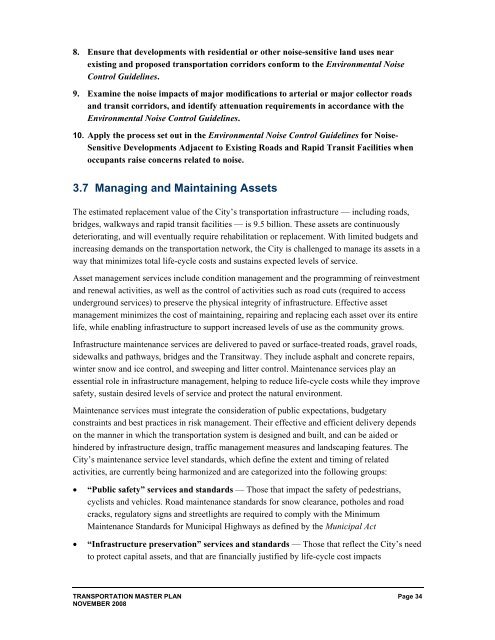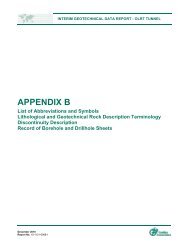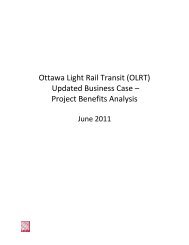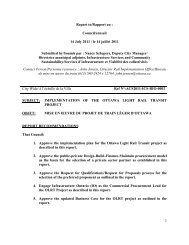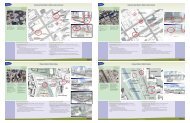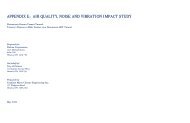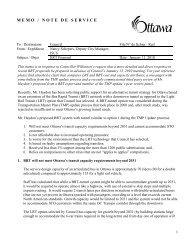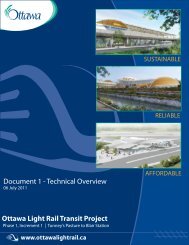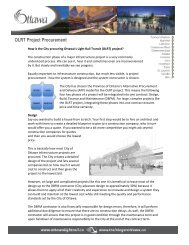Transportation Master Plan - Ottawa Confederation Line
Transportation Master Plan - Ottawa Confederation Line
Transportation Master Plan - Ottawa Confederation Line
Create successful ePaper yourself
Turn your PDF publications into a flip-book with our unique Google optimized e-Paper software.
8. Ensure that developments with residential or other noise-sensitive land uses near<br />
existing and proposed transportation corridors conform to the Environmental Noise<br />
Control Guidelines.<br />
9. Examine the noise impacts of major modifications to arterial or major collector roads<br />
and transit corridors, and identify attenuation requirements in accordance with the<br />
Environmental Noise Control Guidelines.<br />
10. Apply the process set out in the Environmental Noise Control Guidelines for Noise-<br />
Sensitive Developments Adjacent to Existing Roads and Rapid Transit Facilities when<br />
occupants raise concerns related to noise.<br />
3.7 Managing and Maintaining Assets<br />
The estimated replacement value of the City’s transportation infrastructure — including roads,<br />
bridges, walkways and rapid transit facilities — is 9.5 billion. These assets are continuously<br />
deteriorating, and will eventually require rehabilitation or replacement. With limited budgets and<br />
increasing demands on the transportation network, the City is challenged to manage its assets in a<br />
way that minimizes total life-cycle costs and sustains expected levels of service.<br />
Asset management services include condition management and the programming of reinvestment<br />
and renewal activities, as well as the control of activities such as road cuts (required to access<br />
underground services) to preserve the physical integrity of infrastructure. Effective asset<br />
management minimizes the cost of maintaining, repairing and replacing each asset over its entire<br />
life, while enabling infrastructure to support increased levels of use as the community grows.<br />
Infrastructure maintenance services are delivered to paved or surface-treated roads, gravel roads,<br />
sidewalks and pathways, bridges and the Transitway. They include asphalt and concrete repairs,<br />
winter snow and ice control, and sweeping and litter control. Maintenance services play an<br />
essential role in infrastructure management, helping to reduce life-cycle costs while they improve<br />
safety, sustain desired levels of service and protect the natural environment.<br />
Maintenance services must integrate the consideration of public expectations, budgetary<br />
constraints and best practices in risk management. Their effective and efficient delivery depends<br />
on the manner in which the transportation system is designed and built, and can be aided or<br />
hindered by infrastructure design, traffic management measures and landscaping features. The<br />
City’s maintenance service level standards, which define the extent and timing of related<br />
activities, are currently being harmonized and are categorized into the following groups:<br />
• “Public safety” services and standards — Those that impact the safety of pedestrians,<br />
cyclists and vehicles. Road maintenance standards for snow clearance, potholes and road<br />
cracks, regulatory signs and streetlights are required to comply with the Minimum<br />
Maintenance Standards for Municipal Highways as defined by the Municipal Act<br />
• “Infrastructure preservation” services and standards — Those that reflect the City’s need<br />
to protect capital assets, and that are financially justified by life-cycle cost impacts<br />
TRANSPORTATION MASTER PLAN Page 34<br />
NOVEMBER 2008


